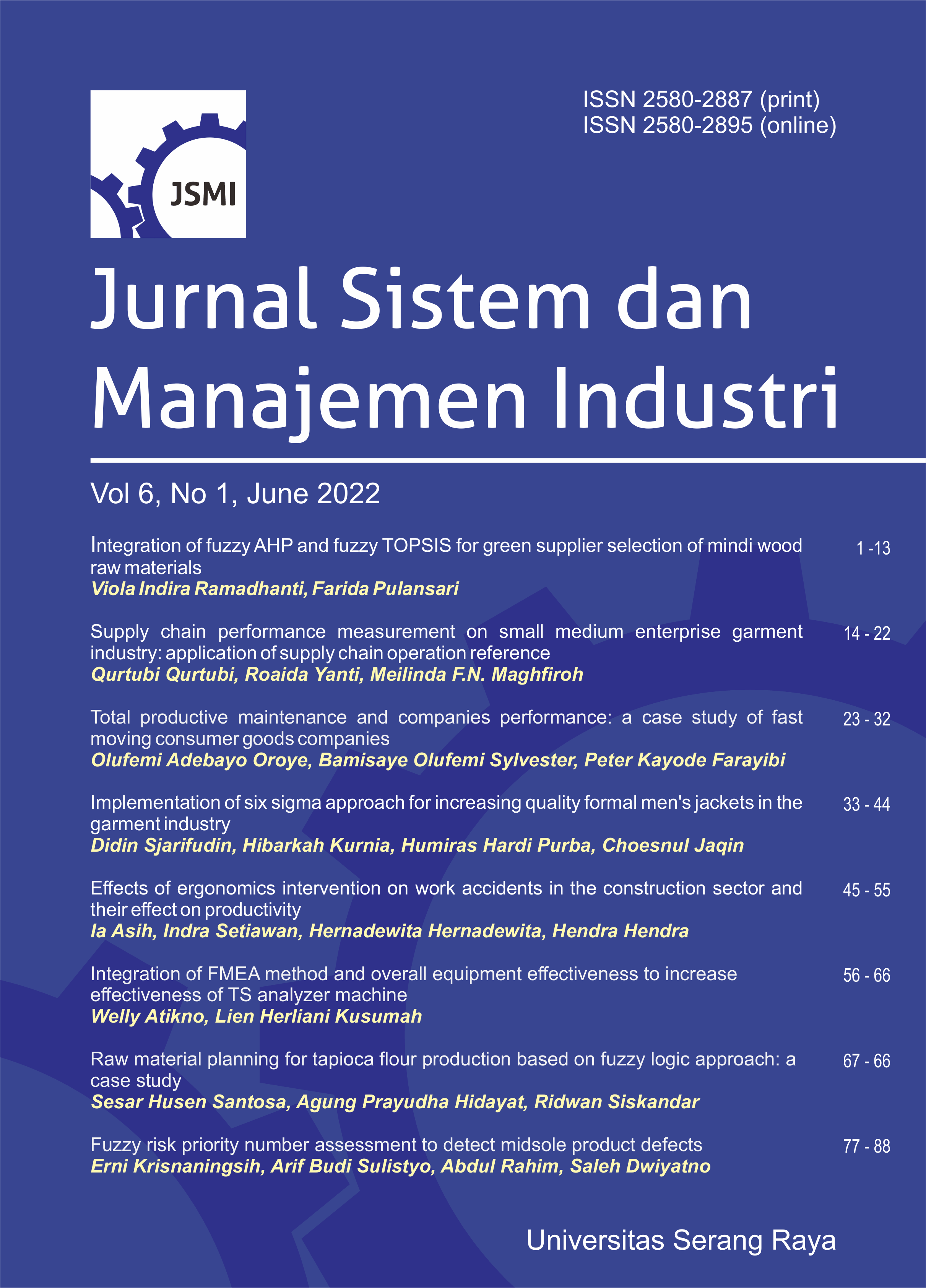Implementation of six sigma approach for increasing quality formal men’s jackets in the garment industry
DOI:
https://doi.org/10.30656/jsmi.v6i1.4359Keywords:
DMAIC, Formal men’s jacket, Garment, Increasing quality, Six sigmaAbstract
This study aims to implement the Six Sigma method on formal men's jacket products in the garment industry to increase the level of sigma. The methodology is based on the Define, Measure, Analyze, Improve, and Control (DMAIC) approach. The new approach in this study is the determination of 5W+1H using a Focus Group Discussion (FGD) with five expert judgments. The design of this study has applied the Six Sigma method at the Measure stage. It is a measurement before improvement and after the Control stage as a measurement after improvement. The results of this study have increased the level of sigma from 3.5765 to 3.7839, so there is an increase of 5.48%. Increasing the sigma level contributes to a decrease in defects at the finish line by 44.09% every month. Implementing the Six Sigma method to the DMAIC approach has succeeded in increasing the level of sigma, automatically reducing the percentage of defects and increasing the productivity of formal men's jackets in the garment industry.
Downloads
References
K. Yang and B. S. El-Haik, Design for Six Sigma: A Roadmap for Product Development, 2nd ed. New York: McGraw-Hill Education, 2009. Available: https://www.accessengineeringlibrary.com/content/book/9780071547673
H. H. Purba, A. Trimarjoko, and F. Fatahillah, “Quality improvement of remanufacturing lift arm using six sigma methods in the heavy-duty industry in Indonesia: A case study,†Oper. Res. Eng. Sci. Theory Appl., vol. 3, no. 2, pp. 24–38, Aug. 2020, doi: https://doi.org/10.31181/oresta2003024s.
H. Kurnia, S. Setiawan, and M. Hamsal, “Implementation of statistical process control for quality control cycle in the various industry in Indonesia: A systematic literature review,†Oper. Excell. J. Appl. Ind. Eng., vol. 13, no. 2, pp. 194–206, Jul. 2021, doi: https://doi.org/10.22441/oe.2021.v13.i2.018.
I. Setiawan and S. Setiawan, “Defect reduction of roof panel part in the export delivery process using the DMAIC method: a case study,†J. Sist. dan Manaj. Ind., vol. 4, no. 2, pp. 108–116, Dec. 2020, doi: https://doi.org/10.30656/jsmi.v4i2.2775.
H. Kurniawan, J. Choesnul, P. H. Hardi, and I. Setiawan, “Implementation of Six Sigma in the DMAIC Approach for Quality Improvement in the Knitting Socks Industry,†Tekst. ve Mühendis, vol. 28, no. 124, pp. 269–278, Dec. 2021, doi: https://doi.org/10.7216/1300759920212812403.
M. Karabulut and P. Y. Kumru, “Six Sigma Methodology and an Application in the Textile Sector,†Kocaeli J. Sci. Eng., vol. 2, no. 1, pp. 7–20, May 2019, doi: https://doi.org/10.34088/kojose.453692.
A. Rahman, S. U. C. Shaju, S. K. Sarkar, M. Z. Hashem, S. M. K. Hasan, and U. Islam, “Application of Six Sigma using Define Measure Analyze Improve Control (DMAIC) methodology in Garment Sector,†Indep. J. Manag. Prod., vol. 9, no. 3, pp. 810–826, Sep. 2018, doi: https://doi.org/10.14807/ijmp.v9i3.732.
A. Prashar, “Adoption of Six Sigma DMAIC to reduce cost of poor quality,†Int. J. Product. Perform. Manag., vol. 63, no. 1, pp. 103–126, Jan. 2014, doi: https://doi.org/10.1108/IJPPM-01-2013-0018.
Y. He, X. Tang, and W. Chang, “Technical decomposition approach of critical to quality characteristics for Product Design for Six Sigma,†Qual. Reliab. Eng. Int., vol. 26, no. 4, pp. 325–339, Jun. 2010, doi: https://doi.org/10.1002/qre.1077.
M. R. Suryoputro, M. Sugarindra, and H. Erfaisalsyah, “Quality Control System using Simple Implementation of Seven Tools for Batik Textile Manufacturing,†IOP Conf. Ser. Mater. Sci. Eng., vol. 215, no. 1, p. 012028, Jun. 2017, doi: https://doi.org/10.1088/1757-899X/215/1/012028.
N. Mayang, T. A. Koeswandi, and S. Yulianti, “The Analysis of Quality Control in Garment Company Using Statistic in Controling Product,†in Proceedings of the 2016 Global Conference on Business, Management and Entrepreneurship, 2016, pp. 254–258, doi: https://doi.org/10.2991/gcbme-16.2016.47.
N. G. S. Ahmed, H. S. Abohashima, and M. F. Aly, “Defect reduction using Six Sigma methodology in home appliance company: A case study,†Proc. Int. Conf. Ind. Eng. Oper. Manag., vol. 2018, pp. 1349–1358, 2018. Available: http://ieomsociety.org/dc2018/papers/364.pdf.
J. Ravichandran, “Six Sigma-based X-BAR control chart for continuous quality improvement,†Int. J. Qual. Res., vol. 10, no. 2, pp. 257–266, 2016. Available: https://oaji.net/articles/2016/452-1466614588.pdf.
A. R. C. Herrera, J. del P. U. Aguirre, and L. L. L. Leyva, “Application of six sigma in improving the quality of recyclable polymer in collection centers,†in Proceedings of the International Conference on Industrial Engineering and Operations Management, 2019, pp. 1053–1062. Available: http://ieomsociety.org/pilsen2019/papers/278.pdf.
N. A. N. Aziz, R. Ahmad, S. A. Mustafa, T. C. Sin, and M. S. Jusoh, “Application of lean six sigma methodology to improve the weight inconsistency problem of coffee powder packaging,†J. Sist. dan Manaj. Ind., vol. 5, no. 2 SE-Research Article, pp. 74–86, Nov. 2021, doi: https://doi.org/10.30656/jsmi.v5i2.3729.
I. Madanhire and C. Mbohwa, “Application of Statistical Process Control (SPC) in Manufacturing Industry in a Developing Country,†Procedia CIRP, vol. 40, pp. 580–583, 2016, doi: https://doi.org/10.1016/j.procir.2016.01.137.
A. D. Prabaswari and A. J. Susilo, “Analysis of quality control of chippendale furniture products using seven tools approach (case study of PT. Bothwell Indonesia),†IOP Conf. Ser. Mater. Sci. Eng., vol. 982, no. 1, p. 012052, Dec. 2020, doi: https://doi.org/10.1088/1757-899X/982/1/012052.
Ã. Medinilla, Agile Kaizen. Berlin, Heidelberg: Springer Berlin Heidelberg, 2014, doi: https://doi.org/10.1007/978-3-642-54991-5
A. M. H. Pereira, M. R. Silva, M. A. G. Domingues, and J. C. Sá, “Lean Six Sigma Approach to Improve the Production Process in the Mould Industry: a Case Study,†Qual. Innov. Prosper., vol. 23, no. 3, p. 103, Nov. 2019, doi: https://doi.org/10.12776/qip.v23i3.1334.
M. M. Saxena and K. V. N. Srinivas Rao, “Quality management, total quality management and six sigma,†Int. J. Sci. Technol. Res., vol. 8, no. 12, pp. 394–399, 2019. Available: http://www.ijstr.org/final-print/dec2019/Quality-Management-Total-Quality-Management-And-Six-Sigma.pdf.
N. Radziwill, “Quality Management for Organizations Using Lean Six Sigma Techniques,†Qual. Manag. J., vol. 21, no. 3, pp. 62–62, Jan. 2014, doi: https://doi.org/10.1080/10686967.2014.11918397.
A. Chakrabarty and K. Chuan Tan, “The current state of six sigma application in services,†Manag. Serv. Qual. An Int. J., vol. 17, no. 2, pp. 194–208, Mar. 2007, doi: https://doi.org/10.1108/09604520710735191.
A. R. Costa, C. Barbosa, G. Santos, and M. Ru. Alves, “Six Sigma: Main Metrics and R Based Software for Training Purposes and Practical Industrial Quality Control,†Qual. Innov. Prosper., vol. 23, no. 2, pp. 83–100, Jul. 2019, doi: https://doi.org/10.12776/qip.v23i2.1278.
Y. Praharsi, M. A. Jami’in, G. Suhardjito, and H. M. Wee, “Six sigma implementation and analysis-An empirical study of a traditional boat building industry in Indonesia,†in Proceedings of the International Conference on Industrial Engineering and Operations Management, 2020, vol. 0, no. March, pp. 3092–3100. Available: http://www.ieomsociety.org/ieom2020/papers/880.pdf.
H. Kurnia, C. Jaqin, and H. Manurung, “Implemantation of the DMAIC Approach for Quality Improvement at the Elastic Tape Industry,†J@ti Undip J. Tek. Ind., vol. 17, no. 1, pp. 40–51, 2022, doi: https://doi.org/10.14710/jati.17.1.40-51.
H. Kurnia, C. Jaqin, and H. H. Purba, “Quality Improvement with the DMAIC Approach Using the Implementation of Benchmarking and KPI Methods,†in Industrial Engineering and Operations Management (IEOM), 2022, vol. 2, no. 9, pp. 2122–2133. Available: http://ieomsociety.org/proceedings/2021indonesia/400.pdf.
J. W. Creswell, Research Design: Qualitative, Quantitative, and Mixed Methods Approaches. SAGE Publications, 2014. Available: https://books.google.co.id/books?id=4uB76IC_pOQC.
P. Gangidi, “A systematic approach to root cause analysis using 3 × 5 why’s technique,†Int. J. Lean Six Sigma, vol. 10, no. 1, pp. 295–310, Jan. 2019, doi: https://doi.org/10.1108/IJLSS-10-2017-0114.
D. I. Sukma, H. A. Prabowo, I. Setiawan, H. Kurnia, and I. M. Fahturizal, “Implementation of Total Productive Maintenance to Improve Overall Equipment Effectiveness of Linear Accelerator Synergy Platform Cancer Therapy,†Int. J. Eng., vol. 35, no. 07, pp. 1–11, 2022, doi: https://doi.org/10.5829/IJE.2022.35.07A.05.
D. M. Zaman and N. H. Zerin, “Applying DMAIC Methodology to Reduce Defects of Sewing Section in RMG: A Case Study,†Am. J. Ind. Bus. Manag., vol. 07, no. 12, pp. 1320–1329, 2017, doi: https://doi.org/10.4236/ajibm.2017.712093.
R. Setyaningrum, Miftakhul Ulum, and Tita Talitha, “Redesign of Cassava Cutting Tools Using Rational Methods to Increase Productivity,†J. Sist. Tek. Ind., vol. 22, no. 1, pp. 52–62, 2020, doi: https://doi.org/10.32734/jsti.v22i1.3255.
E. Grigoryan and I. Golubkova, “Seven Tools for Quality Management and Control: Theory and Practice,†vol. 139, no. Icemt, pp. 528–535, 2020, doi: https://doi.org/10.2991/aebmr.k.200509.094.
R. Ginting, Wanli, and A. Fauzi Malik, “Crude Palm Oil Product Quality Control Using Seven Tools (case study: XYZ Company),†IOP Conf. Ser. Mater. Sci. Eng., vol. 851, no. 1, 2020, doi: https://doi.org/10.1088/1757-899X/851/1/012046.
R. D. Adikorley, L. Rothenberg, and A. Guillory, “Lean Six Sigma applications in the textile industry: a case study,†Int. J. Lean Six Sigma, vol. 8, no. 2, 2017, doi: https://doi.org/10.1108/ijlss-03-2016-0014.
R. Dinulescu and A. DIMA, “Improving Performance In Romanian Garment Industry By Using The Lean Six Sigma Methodology,†in Proceedings of the International Management Conference, 2019, vol. 13, no. 1, pp. 711–721. Available: http://conference.management.ase.ro/archives/2019/pdf/3_19.pdf
M. Ahmed, T. Islam, and M. D. S. Ali, “Study on different types of defects and their causes and remedies in garments industry,†J. Text. Eng. Fash. Technol., vol. 5, no. 6, pp. 300–304, 2019, doi: https://doi.org/10.15406/jyeft.2019.05.00217.
Downloads
Published
Issue
Section
License
All articles in Jurnal Sistem dan Manajemen Industri can be disseminated provided they include the identity of the article and the source of the article Jurnal Sistem dan Manajemen Industri. The publisher is not responsible for the contents of the article. The content of the article is the sole responsibility of the author
Jurnal Sistem dan Manajemen Industri is licensed under a Creative Commons Attribution-NonCommercial-ShareAlike 4.0 International License.
















1.png)
.png)
.png)
.png)


